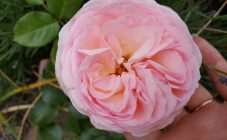Content:
Rose is one of the brightest and most beautiful representatives of the world flora. A large exquisite bud, emitting a captivating aroma, will leave few people indifferent. The Midsummer rose is very popular. The description of the flower, the rules for planting and caring for this plant will be discussed below.
Brief description of the Midsummer variety
The variety belongs to the floribunda group. The flower has high decorative qualities, so it is often used in landscape design.
Floribunda roses were obtained as a result of crossing several varieties of culture at once: nutmeg, tea, polyanthus roses. Plants of this group turned out to be strong, winter-hardy, disease-resistant with a long flowering period. The quality of the flowers is at the highest level, the varieties are varied, dazzling with an abundance of colors. In addition, the floribunda group is unpretentious and easy to grow and care for.
Depending on the variety, the bushes can grow from 30 to 100 cm in height. At the tops of the stems, a lush shock of bright, saturated colors is formed. They are also different to the touch: some are terry, others are smooth. In shape, the buds are cupped or goblet.
The diameter of the flowers varies from 4 to 10 cm. The flowering period is mid-summer. It does not occur in one wave, like in other groups, but continues throughout the season. Of course, this is the particular advantage of floribunda roses over other crops.
Plants in this group can be grown as a shrub, as a small tree or as a house flower. It is for this reason that the scope of application of floribunda varieties is very diverse: they are used to decorate garden and summer cottages, loggias, flower beds, gazebos, ordinary apartments.
Features of culture
The maximum height of the bush is 1 m, and the width is 60 cm. In diameter, the flowers reach 60, sometimes 80 mm, while their number on one stem exceeds a dozen. Each flower has approximately 30 petals. The color palette of the Midsummer variety is very diverse: the outside of the bud is painted in dark yellow tones, and the inside is in deep pink, bright crimson, red, scarlet or cherry.
Distinctive characteristics of the variety:
- erect stems;
- compact bush;
- leaves of medium size, rich green with a glossy surface;
- flowers are collected in small bouquets growing on one shoot;
- flowering begins in mid-June.
Thanks to this combination, the shrub looks very elegant, festive. According to some experts, a large number of small flowers, behind which green leaves are almost invisible, is a disadvantage of the variety, which reduces its decorative properties. The buds bloom at different times, so both very young flowers and wilting ones can be located nearby. Favorably distinguishes this variety from other floribunda by a rather weak, but at the same time very pleasant, unusual, attractive aroma.
Growing and care
Caring for Midsummer is not difficult. Seedlings with an open root system are planted in the spring in a soil well warmed by the sun's rays or in the fall, when the soil has not yet had time to freeze and harden.The exact dates of planting depend on the characteristics of the climate in a particular region. It is necessary to find such a moment so that the flower has time to take root and get stronger, but at the same time does not actively grow and develop. For planting Midsummer in the Russian regions of the Middle Lane, September and the first decade of October are ideal. If the plant was sold in a container with ready-made soil, planting can be done even in summer.
Shrub pruning should be gentle. The main goal of the event is to rid the plant of damaged and diseased shoots, as well as to free the rose from overgrown stems.
This variety needs spring feeding, only in this case the plant will be able to form such a large number of beautiful buds.
In the process of active growth and development, the rose is fed with complex organic and mineral fertilizers. There are 2 options here:
- The flower is fertilized 2 times a month, alternating organic matter with mineral additives.
- A general mixture is made and also introduced into the soil 2 times a month. It is made from manure and water in a ratio of 1: 3, then potassium, nitrogen and superphosphate are added to it. Then it all mixes well. The mixture should be fermented for 2 weeks. For irrigation, 1 part of the fertilizer is used, previously mixed with 10 liters of water.
Despite the frost resistance of the flower, in regions with very cold winters, Midsummer (Midsummer) rose is advised to spud to a height of about 35 cm or mulch with sawdust, cover with spruce branches or peat.
This variety is very rarely subject to disease. The shrub is not susceptible to powdery mildew and black spot. Does not suffer from high humidity in rainy weather. And yet, despite the high immunity, the plant sometimes gets sick, and the wrong care becomes the cause. In particular, abundant watering can cause root decay. Further, the rose will not be able to form flowers if it does not have enough sunlight, heat and fertilizer.
In addition to diseases, pests are dangerous to the plant:
- scabbards;
- aphid;
- spider mite.
To get rid of parasites, the shrub should be treated with insecticides.
Rosa Midsummer is susceptible to such a serious disease as bacterial cancer. Signs of the disease are dark spots on the shoots. In order to prevent the spread of the disease to other plant tissues, all infected stems should be cut off, and the shrub should be treated with Bordeaux liquid or copper sulfate.
Advantages and disadvantages of the variety
Climbing rose Midsummer has a number of positive qualities and properties. These include:
- great appearance;
- nice smell;
- unpretentiousness of the plant and, as a result, ease of growing and caring for a flower;
- frost resistance;
- high immunity to diseases, rarely exposed to pests;
- the plant easily tolerates heat;
- resistance to high humidity;
- constant long flowering throughout the season;
- when cut, the flower holds its shape for a very long time, therefore it is ideal for bouquet arrangements.
There are almost no disadvantages of this variety. Some gardeners note the flower size is too small, and too many of them do not compensate for the lack at all. The fact is that numerous small buds obscure the foliage, thereby reducing the decorative qualities of the shrub.
Midsummer rose is one of the best hybrids of this crop.The plant is not only very beautiful, but also absolutely unpretentious, so even an inexperienced florist can grow it in a garden or in a summer cottage.















